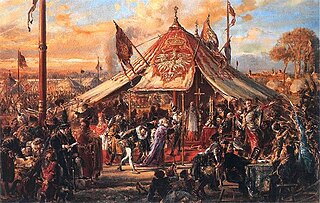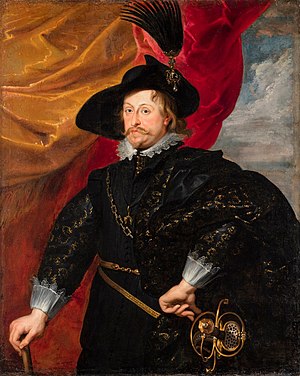
Sigismund III Vasa was King of Poland and Grand Duke of Lithuania from 1587 to 1632 and, as Sigismund, King of Sweden and Grand Duke of Finland from 1592 to 1599. He was the first Polish sovereign from the House of Vasa. Religiously zealous, he imposed Catholicism across the vast realm, and his crusades against neighbouring states marked Poland's largest territorial expansion. As an enlightened despot, he presided over an era of prosperity and achievement, further distinguished by the transfer of the country's capital from Kraków to Warsaw.

The House of Vasa or Wasa was an early modern royal house founded in 1523 in Sweden. Its members ruled the Kingdom of Sweden from 1523 to 1654 and the Polish–Lithuanian Commonwealth from 1587 to 1668; its agnatic line became extinct with the death of King John II Casimir of Poland in 1672.

Władysław IV Vasa or Ladislaus IV of Poland was King of Poland, Grand Duke of Lithuania and claimant of the thrones of Sweden and Russia. Born into the House of Vasa as a prince of Poland and of Sweden, Władysław IV was the eldest son of Sigismund III Vasa and Sigismund's first wife, Anna of Austria.

John II Casimir Vasa was King of Poland and Grand Duke of Lithuania from 1648 to his abdication in 1668 as well as a claimant to the throne of Sweden from 1648 to 1660. He was the first son of Sigismund III Vasa with his second wife Constance of Austria. John Casimir succeeded his older half-brother, Władysław IV Vasa.

The Polish–Lithuanian Commonwealth, formally known as the Kingdom of Poland and the Grand Duchy of Lithuania and also referred to as Poland–Lithuania or the First Polish Republic, was a federative real union between the Kingdom of Poland and the Grand Duchy of Lithuania, existing from 1569 to 1795. This state was among the largest and most populated countries of 16th- to 17th-century Europe. At its peak in the early 17th century, the Commonwealth spanned nearly 1,000,000 km2 (390,000 sq mi) and supported a multi-ethnic population of approximately 12 million as of 1618. The official languages of the Commonwealth were Polish and Latin, with Catholicism as the state religion.

Golden Liberty, sometimes referred to as Golden Freedoms, Nobles' Democracy or Nobles' Commonwealth was a political system in the Kingdom of Poland and, after the Union of Lublin (1569), in the Polish–Lithuanian Commonwealth. Under that system, all nobles (szlachta), regardless of rank, economic status or their ethnic background were considered to have equal legal status and enjoyed extensive legal rights and privileges. The nobility controlled the legislature and the Commonwealth's elected king.

Pacta conventa was a contractual agreement entered into between the "Polish nation" and a newly elected king upon his "free election" to the throne from 1573 to 1764. It declared policies the King would enact once on the throne.

The Henrician Articles or King Henry's Articles were a constitution in the form of a permanent agreement made in 1573 between the "Polish nation" and a newly-elected Polish king and Lithuanian grand duke upon his election to the throne. The Articles were the primary constitutional law of the Polish–Lithuanian Commonwealth.

Royal elections in Poland were the elections of individual kings, rather than dynasties, to the Polish throne. Based on traditions dating to the very beginning of the Polish statehood, strengthened during the Piast and Jagiellon dynasties, they reached their final form in the Polish–Lithuanian Commonwealth period between 1572 and 1791. The "free election" was abolished by the Constitution of 3 May 1791, which established a constitutional-parliamentary monarchy.

Prince Krzysztof Radziwiłł was a Polish–Lithuanian noble (szlachcic), and a notable magnate, politician and military commander of his epoch. Sometimes referred to as Krzysztof Radziwiłł II, to distinguish him from his father, Krzysztof Mikołaj 'Piorun' Radziwłł.

The Smolensk War (1632–1634) was a conflict fought between the Polish–Lithuanian Commonwealth and Russia.

Polish–Lithuanian Commonwealth Navy was the navy of the Polish–Lithuanian Commonwealth.
Władysław Czapliński was a Polish historian, a professor of the University of Wrocław, author of many popular books about Polish history.

Urszula Meyerin was a politically influential Polish courtier and mistress to King Sigismund III of Poland. Her real surname may have been Gienger, but that remains in dispute; she signed her letters Ursula Meyerin. In the German language, that surname means "chamberlain", "administrator", "manager".
The early modern era of Polish history follows the Late Middle Ages. Historians use the term early modern to refer to the period beginning in approximately 1500 AD and lasting until around the Napoleonic Wars in 1800 AD.
The history of the Polish–Lithuanian Commonwealth (1569–1648) covers a period in the history of Poland and Lithuania, before their joint state was subjected to devastating wars in the mid-17th century. The Union of Lublin of 1569 established the Polish–Lithuanian Commonwealth, a more closely unified federal state, replacing the previously existing personal union of the two countries. The Union was largely run by the Polish and increasingly Polonized Lithuanian and Ruthenian nobility, through the system of the central parliament and local assemblies, but from 1573 led by elected kings. The formal rule of the nobility, which was a much greater proportion of the population than in other European countries, constituted a sophisticated early democratic system, in contrast to the absolute monarchies prevalent at that time in the rest of Europe.[a]

The free election of 1587 was the third royal election to be held in the Polish–Lithuanian Commonwealth, which took place after the death of King Stefan Batory. It began on June 30, 1587, when Election Sejm was summoned in the village of Wola near Warsaw, and ended on December 27 of the same year, when King Sigismund III was crowned in Kraków’s Wawel Cathedral.

The 1648 free election in the Polish–Lithuanian Commonwealth began on 6 October 1648, and ended on November 17 of the same year. The new King of Poland and Grand Duke of Lithuania was John II Casimir, the younger brother of previous king, Władysław IV, who had died on May 20, 1648.

Wojciech Baranowski was archbishop of Gniezno and primate of Poland.

Sylvester Simeon Hulevych-Woyutinsky, also known as Semen Hulevych-Woyutinsky, Symeon Hulevych of Woyutin or Simon Hulevych, of the Nowina coat of arms was the first Orthodox bishop of Przemyśl after the restitution of the Orthodox Church in the Polish–Lithuanian Commonwealth, and a writer in Lutsk from 1628 to 1636.

















